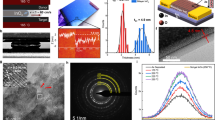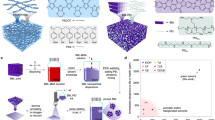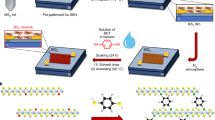Abstract
Although organic semiconductors have received the most attention, the development of compatible passive elements, such as interconnects and electrodes, is also central to plastic electronics. For this, ligand-protected metal-cluster films have been shown to anneal at low temperatures below 250∘C to highly conductive metal films, but they suffer from cracking and inadequate substrate adhesion. Here, we report printable metal-cluster–polymer nanocomposites that anneal to a controlled-percolation nanostructure without complete sintering of the metal clusters. This overcomes the previous challenges while still retaining the desired low transformation temperatures. Highly water- and alcohol-soluble gold clusters (75 mg ml−1) were synthesized and homogeneously dispersed into poly(3,4-ethylenedioxythiophene) to give a material with annealed d.c. conductivity tuneable between 10−4 and 105 S cm−1. These composites can inject holes efficiently into all-printed polymer organic transistors. The insulator–metal transformation can also be electrically induced at 1 MV cm−1, suggesting possible memory applications.
This is a preview of subscription content, access via your institution
Access options
Subscribe to this journal
Receive 12 print issues and online access
$259.00 per year
only $21.58 per issue
Buy this article
- Purchase on Springer Link
- Instant access to full article PDF
Prices may be subject to local taxes which are calculated during checkout






Similar content being viewed by others
References
Crone, B. et al. Large-scale complementary integrated circuits based on organic transistors. Nature 403, 521–523 (2000).
Sirringhaus, H. et al. High-resolution inkjet printing of all-polymer transistor circuits. Science 290, 2123–2126 (2000).
Huitema, H. E. A. et al. Plastic transistors in active matrix displays. Nature 414, 599 (2001).
Kawase, T., Sirringhaus, H., Friend, R. H. & Shimoda, T. Inkjet printed via-hole interconnections and resistors for all-polymer transistor circuits. Adv. Mater. 13, 1601–1605 (2001).
Buffat, P. & Borel, J. P. Size effect on the melting point of gold nanoparticles. Phys. Rev. A 13, 2287–2298 (1976).
Daniel, M. & Astruc, D. Gold nanoparticles: assembly, supramolecular chemistry, quantum-size-related properties, and applications toward biology, catalysis, and nanotechnology. Chem. Rev. 104, 293–346 (2004).
Mayya, K. S. & Sastry, M. A new technique for spontaneous growth of colloidal nanoparticle superlattices. Langmuir 15, 1902–1904 (1999).
Musick, M. D. et al. Metal films prepared by stepwise assembly. 2. Construction and characterization of colloidal Au and Ag multilayers. Chem. Mater. 12, 2869–2881 (2000).
Fuller, S. B., Wilhelm, E. J. & Jacobson, J. M. Ink-jet printed nanoparticle microelectromechanical systems. J. Microelectromech. Syst. 11, 54–60 (2002).
Huang, D., Liao, F., Molesa, S., Redinger, D. & Subramanian, V. Plastic-compatible low resistance printable gold nanoparticle conductors for flexible electronics. J. Electrochem. Soc. 150, 412–417 (2003).
Brust, M., Walker, M., Bethell, D., Schiffrin, D. & Whyman, R. Synthesis of thiol derivatised gold nanoparticles in a two phase liquid-liquid system. J. Chem. Soc., Chem. Commun. 801–802 (1994).
Mayya, K. S., Patil, V. & Sastry, M. On the stability of carboxylic acid derivatized gold colloidal particles: the role of colloidal solution pH studied by optical absorption spectroscopy. Langmuir 13, 3944–3947 (1997).
Johnson, S. R., Evans, S. D. & Brydson, R. Influence of a terminal functionality on the physical properties of surfactant-stabilized gold nanoparticles. Langmuir 14, 6639–6647 (1998).
Chen, S. & Kimura, K. Synthesis and characterization of carboxylate-modified gold nanoparticle powders dispersible in water. Langmuir 15, 1075–1082 (1999).
Templeton, A. C., Chen, S., Gross, S. M. & Murray, R. W. Water-soluble, isolable gold clusters protected by tiopronin and coenzyme A monolayers. Langmuir 15, 66–76 (1999).
Cliffel, D. E., Zamborini, F. P., Gross, S. M. & Murray, R. W. Mercaptoammonium-monolayer- protected, water-soluble gold, silver, and palladium clusters. Langmuir 16, 9699–9702 (2000).
Gittins, D. I. & Caruso, F. Spontaneous phase transfer of nanoparticulate metals from organic to aqueous media. Angew. Chem. Int. Edn 40, 3001–3004 (2001).
Kanaras, A. G., Kamounah, F. S., Schaumburg, K., Kiely, C. J. & Brust, M. Thioalkylated tetraethylene glycol: A new ligand for water soluble monolayer protected gold clusters. Chem. Commun. 2294–2295 (2002).
Hong, R., Emrick, T. & Rotello, V. M. Monolayer-controlled substrate selectivity using noncovalent enzyme-nanoparticle conjugates. J. Am. Chem. Soc. 126, 13572–13573 (2004).
Musick, M. D., Keating, C. D., Keefe, M. H. & Natan, M. J. Stepwise construction of conductive Au colloid multilayers from solution. Chem. Mater. 9, 1499–1501 (1997).
Brust, M., Kiely, C. J., Schiifrin, D. & Bethell, D. Self-assembled gold nanoparticle thin films with nonmetallic optical and electronic properties. Langmuir 14, 5425–5429 (1998).
Abeles, B., Sheng, P., Coutts, M. D. & Arif, Y. Structural and electrical properties of granular metal films. Adv. Phys. 24, 406–461 (1975).
Pike, G. E. & Seager, C. H. Percolation and conductivity: a computer study I. Phys. Rev. B 10, 1421–1434 (1974).
Quinten, M. & Kreibig, U. Optical properties of aggregates of small metal particles. Surf. Sci. 172, 557–577 (1986).
El-Sayed, M. A. & Link, S. Size and temperature dependence of the plasmon absorption of colloidal gold nanoparticles. J. Phys. Chem. B 103, 4212–4217 (1999).
Van de Hulst, H. C. Light Scattering by Small Particles (Wiley, New York, 1957).
Granqvist, C. G. & Hunderi, O. Optical properties of ultrafine gold particles. Phys. Rev. B 16, 3513–3534 (1977).
Scaffardi, L. B., Pellegri, N., de Sanctis, O. & Tocho, J. O. Sizing gold nanoparticles by optical extinction spectroscopy. Nanotechnology 16, 158–163 (2005).
Aspnes, D. E. Optical properties of thin films. Thin Solid Films 89, 249–262 (1982).
Born, M. & Wolf, E. Principles of Optics: Electromagnetic Theory of Propagation, Interference and Diffraction of Light (Cambridge Univ. Press, Cambridge, 1999).
Chua, L. L., Ho, P. K. H., Sirringhaus, H. & Friend, R. H. High stability ultrathin spin-on benzocyclobutene gate dielectric for polymer field-effect transistors. Appl. Phys. Lett. 84, 3400–3402 (2004).
Carchano, H., Lacoste, R. & Segui, Y. Bistable electrical switching in polymer thin films. Appl. Phys. Lett. 19, 414–415 (1971).
Ouyang, J. Y., Chu, C. W., Szmanda, C. R., Ma, L. P. & Yang, Y. Programmable polymer thin film and non-volatile memory device. Nature Mater. 3, 918–922 (2004).
Naber, R. C. G., de Boer, B., Blom, P. W. M. & de Leeuw, D. M. Low-voltage polymer field-effect transistors for nonvolatile memories. Appl. Phys. Lett. 87, 203509 (2005).
Acknowledgements
We thank NUS (Project 144-000-131-112) and A*STAR (Project 052-117-0030) for funding.
Author information
Authors and Affiliations
Corresponding authors
Ethics declarations
Competing interests
The authors declare no competing financial interests.
Supplementary information
Supplementary Information
Supplementary information I, II and II; figures S1 and S2; tables S1 and S2 (PDF 581 kb)
Rights and permissions
About this article
Cite this article
Sivaramakrishnan, S., Chia, PJ., Yeo, YC. et al. Controlled insulator-to-metal transformation in printable polymer composites with nanometal clusters. Nature Mater 6, 149–155 (2007). https://doi.org/10.1038/nmat1806
Received:
Accepted:
Published:
Issue Date:
DOI: https://doi.org/10.1038/nmat1806
This article is cited by
-
Highly conductive films sintered by Au–Ag nanoparticles ink at low temperature
Journal of Materials Science: Materials in Electronics (2023)
-
Facile synthesis of silver malonate conductive MOD ink for screen printing
Journal of Materials Science: Materials in Electronics (2021)
-
Chemical sintering of Ag nanoparticle conductive inks at room temperature for printable electronics
Journal of Materials Science: Materials in Electronics (2021)
-
Preparation of gold-decorated silver nanowires for improving conductivity of electrically conductive adhesives
Journal of Materials Science: Materials in Electronics (2020)
-
Preparation of highly conductive silver nanowires for electrically conductive adhesives
Journal of Materials Science: Materials in Electronics (2019)



